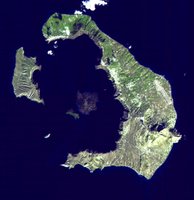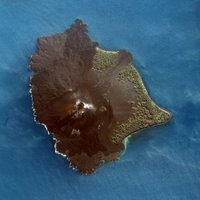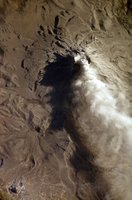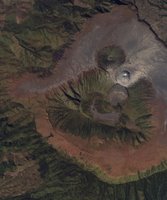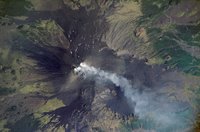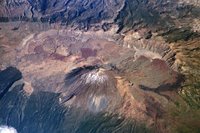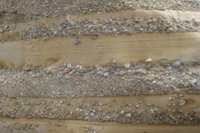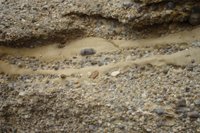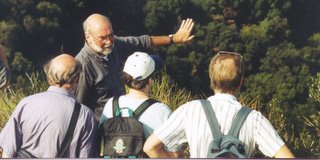



By performing traditional dances and offering food, the people around Mount Merapi volcano try to avert an eruption.
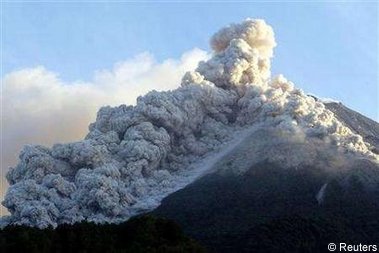
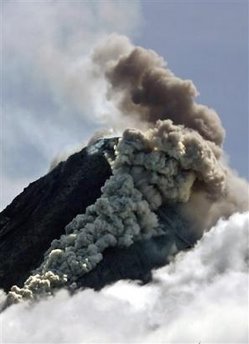
May13
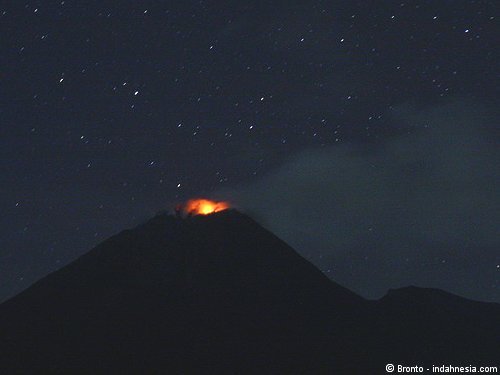
11may
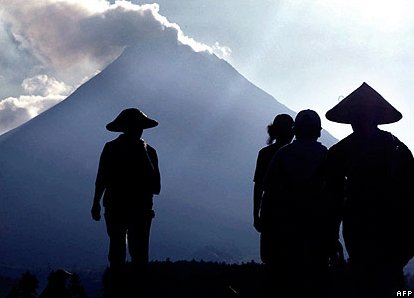
Apr 06
End of Apr 2006.
The geological world is looking at Indonesia, where the Merapi volcano is becomming
more and more active (level 4) A major eruption is to be expected. Gunung Merapi is located in the southern area of central Java, overlooking the ancient royal city of Yogyakarta, is the most active volcano in Indonesia. Merapi has been witnessing small eruptions every two or three years, bigger ones every 10-15 years, and very large ones every 50-60 years.
see also
INDAHNESIA.COMIt is now Mai 3th 2006. The volcano dome is still growing threathning the villages below. Recent measurements show that the dome has grown in volume to 2.4 million cubic meters. If the dome collapses, pyroclastic flow might rush down the slopes of the volcano. The dome has grown in height by 10 meters in 3 days.
Mai 4th. Merapi starts making rumbling sounds and people are urged to leave the area around the volcano. Former President Megawati Soekarnoputri has said Mt Merapi might erupt before May 6, 2006 and therefore residents living on its slopes should immediately be evacuated to safer locations. "
This is not a prediction, but a possibility.
Mai 4th. The
first lava flow started at 2 a.m. local time although the local customary guardian of the volcano, an elderly man named Marijan, officially appointed by the royal house of Yogyakarta, had said that there are no signs yet of an immediate eruption.
Merapi has become increasingly critical following the appearace a new crater and increasing magma pressures on its top.
At least 25 multiphase tremors and seven lava fallouts were recorded. Meanwhile, more magma is expected to escape from the beneath of the volcano. Earlier, on Wednesday, some 197 multiphase tremors, two tectonic earthquakes, a shallow volcanic earthquake and 29 fallouts were recorded.
May Thursday 11th , Merapi is spewing molten lava as far as 1,500 metres from its crater. Vice President Jusuf Kalla , urge an immediate evacuation of people living on the slopes. Hotel owners , received bookings from volcano hunters form over the world. I received an E-mail from
Gomagma today whether I would join their Merapi trip, but I've already vacations planned.
May 13 Indonesian scientists have raised the alert status
(level5) for the Mount Merapi volcano to its highest level, prompting mandatory evacuation of residents living near the mountain. Merapi, has spewed pyroclastic flows since 8:30 a.m. local time today.
15 May 2006 - Clouds of deadly ash, rock fragments and hot gas surged down Mount Merapi's slopes Monday as activity intensified to the highest level since the volcano rumbled back to life weeks ago. One eruption sent an avalanche of debris and ash rolling more than 2 miles down the mountain's western flank.
16 may 2006, Ash rain from the volcano has extended 13 kilometers (8 miles) north of the volcano, said Triani, an officer on duty at the Volcano Development and Research Center in Yogyakarta city. The lava dome has reached a height of about 85 meters (280 feet) over the past two weeks, Triani said. Lava dome collapses can set off pyroclastic flows, or the superheated flow of molten rock, ash and gases.
YOGYAKARTA, 07 June 2006 - The 9,700-foot (2,900-meter) volcano on the Indonesian island of Java has been sporadically spewing clouds of toxic gas and lava for several weeks. Experts believe a major eruption could come at any time. Villagers were being trucked away from the foot of the mountain to temporary shelters.
"Of course it is dangerous. But we don't know for sure whether the lava dome will collapse," Subandriyo, a government volcanologist who uses only one name, told the Associated Press. Officials said a cloud of gas from Merapi stretched for 2.4 miles (4 kilometers), and piles of lava were pushed up to 4 miles (7 kilometers) from the crater, according to the news reports.
Activity in the region has increased since a magnitude 6.3 earthquake struck about 20 miles (30 kilometers) to the south of the volcano on May 27. The earthquake killed more than 5,800 people. Scientists believe the earthquake may have contributed to the increased activity at the volcano.
"I don't think that's unreasonable. The volcano is an unstable pile of rock. It's fragile," said Stanley Williams, a volcanologist at Arizona State University in Tempe who has studied Merapi. "I would be surprised if [the earthquake] didn't literally shake the mountain," he added. A major eruption of Merapi could strain quake-relief efforts.
 REF: WWW.REDORBIT.COM
REF: WWW.REDORBIT.COM